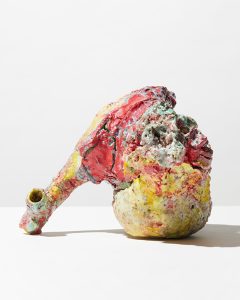Sculptural ceramics have the art world buzzing
Function meets fine art in an ancient medium that seems as contemporary as ever
Amidst the wallpaper, furniture, and art in Before Yesterday We Could Fly, the Afrofuturist period room at the Metropolitan Museum of Art in New York, colorful plates, cups and ashtrays bring an artistic utilitarian flair to the space. These sculptural objects—with portraits of Black cultural figures like Nina Simone, Martin Luther King and Beyoncé by ceramicist Roberto Lugo—reveal the importance and increased visibility of contemporary ceramics.
Functional ceramics reference a long history of human innovation. Today, contemporary artists are pushing the technical and creative extremes of craft. Sometimes these thought-provoking ceramics are sculptures, and sometimes they are objects useful for everyday pleasures: Why not serve your mint tisane in musician-themed teapot?
A look at contemporary ceramics

Aneta Regel. Organ (2019). Courtesy of the Jason Jacques Gallery.
Ceramics refers to a mixture of clay, water and various additives that is shaped and fired. Both pottery and porcelain are kinds of ceramics; porcelain is translucent, and pottery is not. Clay is an accessible material—making it a medium that many can participate in. Creation can be as simple as forming a shape with your hands.
Early civilizations needed to carry water, and later oil and wine, in non-porous vessels, so ceramics have been vital to human history. This utilitarian connection means ceramics have long been classified as crafts, rather than fine art. Yet, the work of many contemporary artists and potters reveal the difficulty of drawing a distinction between craft and art.
With so many practitioners, and so many formal and philosophical approaches to ceramics, I’ve focused on three ways to frame some of the visual and creative expressions of this historical medium that seems more contemporary than ever.
1. Ceramics creating conversations
The purpose of a ceramic can be functional, aesthetic or both. A new generation of potters is adding another dimension—using ceramic vessels as a conduit to share messages and engage.
This makes sense, as the original purpose of clay vessels was to support social engagement. Vessels that were able to transport liquids for cooking, or created for important rituals and ceremonies, underscored human connection through shared ceremonies. Artists and ceramicists today are also engaging in social and cultural conversations through their work.
For example, Philadelphia-based Roberto Lugo describes himself as the “Village Potter” and his artistic goal is “to become a facet of the community that not only contributes beautiful, functional objects, but enriches and empowers the culture and lives of others through art and design.”1 It’s a message he is sharing with many through his inclusion in the AfroFuturist room at the Met.
Chicago-based artist Theaster Gates has recently returned to his pottery practice, with a recent exhibition at the Tate Gallery in London. As he stated in a TED talk a few years ago,
“I spent about 15 years making pots … you very quickly learn how to make great things out of nothing. I feel like as a potter you also start to learn how to shape the world.”
2. Reviving ceramic traditions
In some communities, ceramics have a long cultural history. This rings true for many Indigenous tribes of the Americas. For instance, the Pueblo people of the Southwest have a long tradition of clay pottery making in North America. Pueblo pots were historically made by the women of the tribe, by hand. Traditionally, the three major functions of Pueblo pottery have been:
- utility
- ceremony
- art/trade
Contemporary Indigenous artists often fuse all three in their practice. Take New Mexico-based artist Rose Simpson, who has been recognized for her contemporary interpretation of pottery-making techniques learned from her maternal ancestors. (We recently discussed Simpson’s work in our 2021 year-end art insights webinar.)
3. Spotlight on sculptural ceramics
Sometimes the medium itself is the message, which brings us to our third contemporary ceramic expression—that is, artists creating forms and shapes that highlight clay’s transformative possibilities. Polish-born artist Aneta Regel, who lives and works in London, is one artist exploring the boundaries of sculptural ceramics. Her amorphous sculptures with fissures, cracks, twists and hollows highlighted in glazes of scarlet, saffron, and turquoise bursts of color can suggest fantastic natural outgrowth we might see on another planet.
In works like Minion and Escaping, the jagged forms look like specimens or creatures from a Martian terrain. Regel elicits the viewer’s response to a flight of fancy in the complex texture she achieves. She often supplements clay and layers of glaze with volcanic rock materials including basalt, granite, and feldspars to form the main body of her pieces.
This is not your grandmother’s smooth and perfect porcelain teacup surface. Instead, Regel’s artistic alchemy of bold glazes and assorted minerals convert humble earthly origins of clay and rocks into fantastical sculptures with personalities and grandeur of galactic meteorites.
Whether an artist is expanding or redefining the limits of the ceramic medium, the viewer is always engaged by the artist’s engagement in navigating artistic possibilities between still life and sculpture, utility and aesthetics, durability and malleability.
A legacy of clay
We understand the history of ceramics due to numerous collections made accessible to museum visitors. Such a collector recently made a very creative donation as part of her legacy planning. Louise Rosenfield donated her collection of over 3,000 ceramics to the Everson Museum of Art in Syracuse, NY, with the stipulation that the ceramics be used by those dining in their restaurant. Architect Zeina Koreitem, a co-founder of the architecture firm who will create the space featuring Rosenfeld’s ceramics, summed up the intent poetically, “Pottery has to participate in the cycle of life.”
With so many artists re-envisioning the way we make, see and use ceramics—there are certainly many ways for us all to engage and participate.
Katja Zigerlig is Vice President, Art, Wine + Collectibles Advisory at Berkley One (a Berkley Company).



